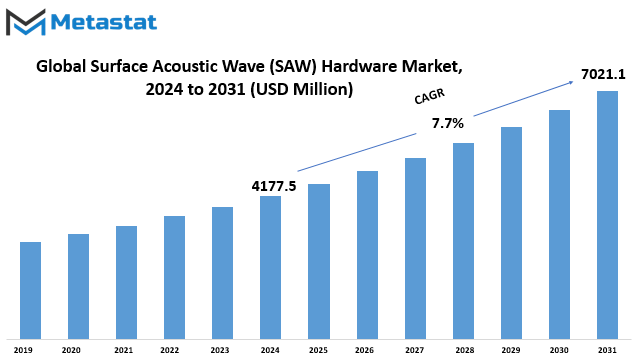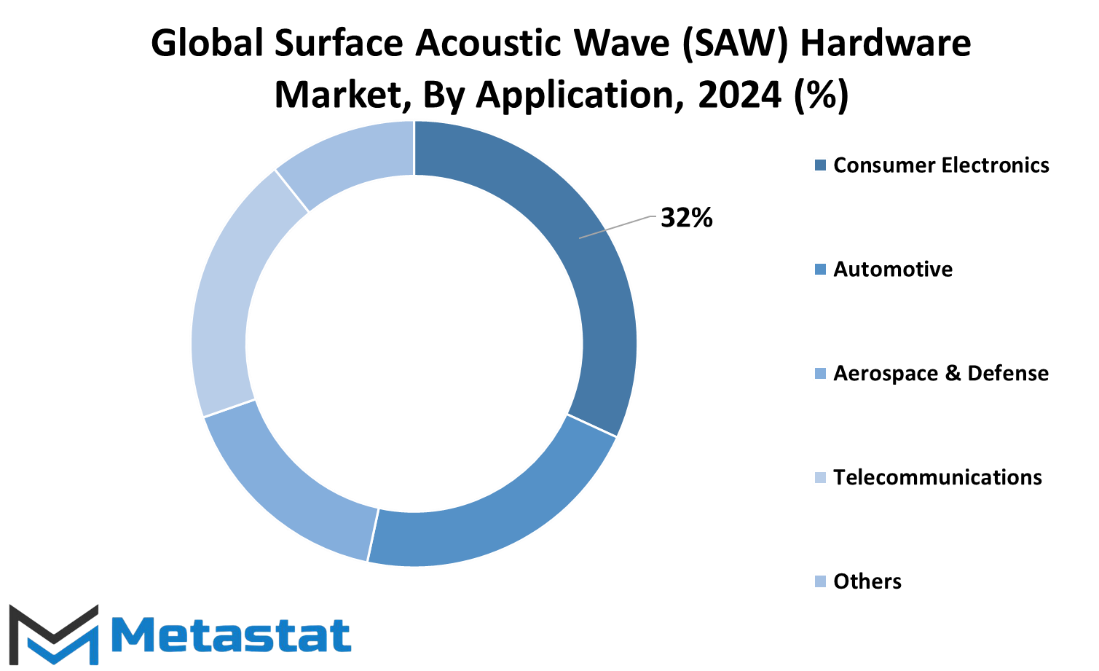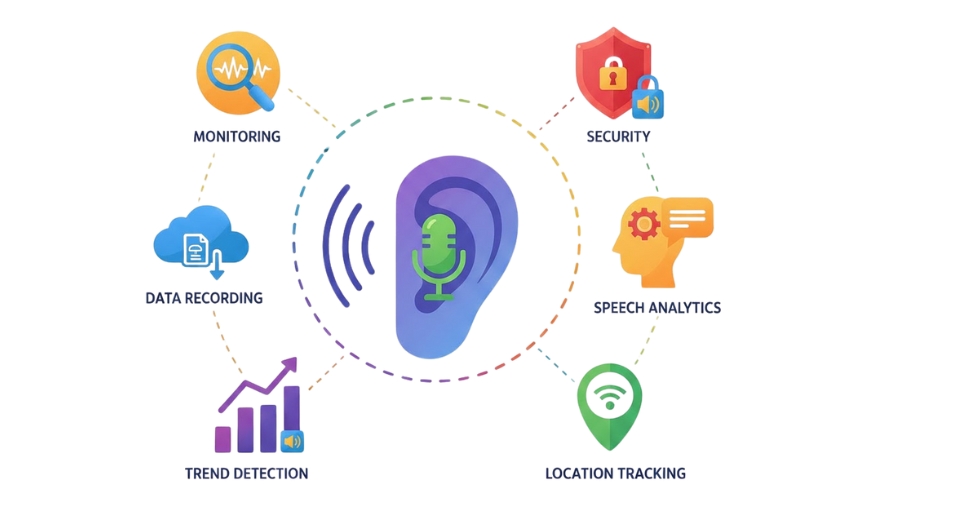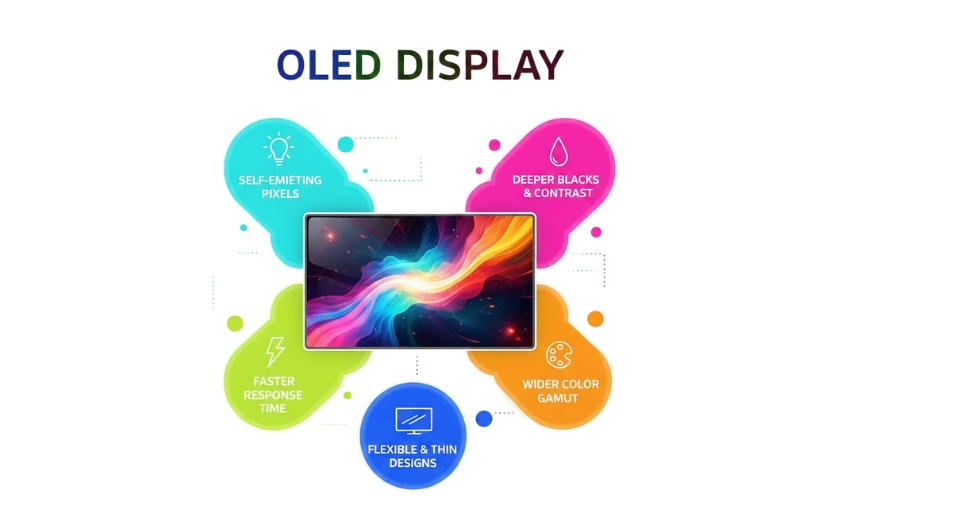MARKET OVERVIEW
The Global Surface Acoustic Wave (SAW) Hardware market plays a crucial role in various applications. This market encompasses a wide array of devices and components that leverage surface acoustic wave technology, contributing to the advancement of communication and sensor technologies.
The Global Surface Acoustic Wave (SAW) Hardware market lies in an intricate interplay of innovation and engineering. The industry revolves around the development and production of devices that utilize surface acoustic waves for signal processing. Unlike traditional electronic components, SAW devices exploit the mechanical vibrations traveling along the surface of a material, offering unique advantages in terms of size, efficiency, and reliability.
One of the notable applications of SAW hardware is in communication systems. SAW filters, for instance, are pivotal components in radio frequency (RF) devices, ensuring the precise filtering of signals. The market for SAW devices in communication systems has witnessed significant growth, driven by the increasing demand for efficient and compact solutions in the ever-evolving landscape of wireless communication.
Beyond communication, the Global Surface Acoustic Wave (SAW) Hardware market finds extensive utility in sensor technologies. SAW sensors are deployed in diverse sectors, ranging from industrial applications to healthcare. These sensors capitalize on the sensitivity of surface acoustic waves to detect changes in various physical parameters, making them invaluable in the development of sophisticated sensing solutions.
Furthermore, the automotive industry has become a key player in the adoption of SAW hardware. The integration of SAW filters and sensors in automotive electronics contributes to enhanced performance and reliability. As vehicles become more technologically advanced, the demand for SAW components is expected to grow, fostering innovation and collaboration within the industry.
The landscape of the Global Surface Acoustic Wave (SAW) Hardware market is characterized by a constant pursuit of excellence in design and functionality. Engineers and researchers in this field strive to push the boundaries of what is achievable, exploring new materials and fabrication techniques to optimize the performance of SAW devices. This dedication to innovation propels the industry forward, ensuring that it remains at the forefront of technological advancements.
As industries worldwide seek solutions that balance efficiency and miniaturization, the Global Surface Acoustic Wave (SAW) Hardware market continues to evolve to meet these demands. The adaptability of SAW technology to various applications positions it as a versatile player in the electronics industry, offering solutions that contribute to the seamless functioning of modern devices and systems.
The Global Surface Acoustic Wave (SAW) Hardware market stands as a testament to the power of ingenuity and engineering in shaping the future of electronics. Through its diverse applications in communication, sensing, and automotive technologies, SAW hardware plays a vital role in driving progress and innovation across industries. The continual pursuit of excellence within the industry ensures that surface acoustic wave technology will remain a key player in shaping the technological landscape for years to come.
Global Surface Acoustic Wave (SAW) Hardware market is estimated to reach $7021.1 Million by 2031; growing at a CAGR of 7.7% from 2024 to 2031.

GROWTH FACTORS
The global market for Surface Acoustic Wave (SAW) Hardware is influenced by various factors that shape its trajectory. One driving force is the rising demand for wireless communication devices. In an era where connectivity is paramount, the need for such devices has surged, propelling the market forward.
Another key driver is the continuous evolution of automotive electronics. As vehicles become more technologically advanced, incorporating cutting-edge electronics has become a norm. This advancement not only caters to consumers' demand for smart features but also contributes to the growth of the SAW Hardware market.
However, the industry faces certain challenges. Technological limitations in high-frequency applications pose a restraint. Despite the progress, there are still hurdles to overcome in achieving optimal performance in these applications, slowing down the overall market growth.
Moreover, there is formidable competition from alternative technologies. As the landscape of electronic solutions expands, SAW Hardware faces rivalry from other methodologies. This competition acts as a hindrance, compelling the industry to innovate and differentiate itself.
Yet, amidst challenges, opportunities arise. The advent of 5G technology is a promising prospect. With the global push towards establishing a robust 5G infrastructure, the SAW Hardware market can leverage this opportunity for growth. The increased reliance on 5G technology opens avenues for applications where SAW Hardware can play a crucial role, presenting a positive outlook for the market.
The dynamics of the global SAW Hardware market are shaped by the interplay of drivers, restraints, and opportunities. The increasing demand for wireless communication devices and advancements in automotive electronics propel the market forward. However, technological limitations and competition from alternative technologies pose challenges. On the brighter side, the growth in 5G technology infrastructure opens doors for the market's expansion, showcasing the resilience and adaptability of the SAW Hardware industry.
MARKET SEGMENTATION
By Type
The global Surface Acoustic Wave (SAW) Hardware market is divided into different types, namely Filters, Oscillators and Resonators, Sensors, and Others. Each type plays a distinct role in the market, contributing to its overall dynamics. The diversity in product types caters to a wide range of applications and requirements within the industry. This segmentation provides a comprehensive understanding of the market landscape, allowing stakeholders to identify specific areas of interest or investment based on their needs.
Filters within the SAW Hardware market serve the purpose of refining signals and managing frequencies, ensuring optimal performance in various electronic devices. Oscillators and Resonators, on the other hand, contribute to the precision and stability of frequency generation, playing a crucial role in applications where accurate timing is essential. Sensors, a significant segment, enable the detection and measurement of various physical phenomena, enhancing the functionality of devices across industries. The category labeled as ‘Others’ encompasses additional components that may not fall directly into the mentioned categories but contribute uniquely to the SAW Hardware market.
This segmentation not only simplifies the understanding of the market but also facilitates targeted analysis and decision-making for businesses operating within this sector. It allows stakeholders to grasp the distinct functionalities and applications associated with each type, promoting a more nuanced comprehension of the global SAW Hardware market. Consequently, this segmentation aids in aligning strategies and resources with specific market demands, fostering efficiency and relevance in a rapidly evolving technological landscape.
By Application
The worldwide Surface Acoustic Wave (SAW) Hardware market spans various sectors, categorized by application into Consumer Electronics, Automotive, Aerospace & Defense, Telecommunications, and Others.
In the global Surface Acoustic Wave (SAW) Hardware market, diverse applications drive its dynamics. Consumer Electronics, a pivotal domain, witnesses the integration of SAW Hardware in devices that permeate our daily lives, emphasizing the market’s significant role in enhancing user experiences.
The Automotive sector, another facet of this market, experiences the infusion of SAW Hardware to augment functionalities and connectivity within vehicles. This inclusion contributes to the evolution of automotive technology, addressing the demands of an increasingly interconnected world.
Aerospace & Defense constitute a critical segment where the incorporation of SAW Hardware plays a vital role in enhancing communication systems and ensuring robust performance in challenging environments. The reliability of SAW Hardware makes it a preferred choice in this sector.
Telecommunications, a cornerstone of modern connectivity, stands as a key application area for SAW Hardware. Its role in signal processing and communication infrastructure underscores its importance in maintaining and advancing global telecommunications networks.
The category labeled as Others encapsulates various applications beyond the specified sectors, showcasing the versatility of SAW Hardware in addressing diverse needs across different industries. This adaptability contributes to its widespread adoption and relevance in an array of contexts.
As the Surface Acoustic Wave (SAW) Hardware market continues to evolve, its influence extends across Consumer Electronics, Automotive, Aerospace & Defense, Telecommunications, and Other applications, shaping technological landscapes and meeting the ever-growing demands of an interconnected world.

REGIONAL ANALYSIS
The worldwide market for Surface Acoustic Wave (SAW) Hardware is analyzed with a focus on geographical segmentation. This categorization includes North America and Europe, among other regions. The examination aims to comprehend the market dynamics and trends specific to each geographic area.
In assessing the Surface Acoustic Wave (SAW) Hardware market, it is crucial to consider its regional distribution. North America and Europe serve as significant segments within this global landscape. By scrutinizing the market through a geographic lens, we gain insights into how diverse regions contribute to the overall dynamics of the industry.
In the context of the global Surface Acoustic Wave (SAW) Hardware market, North America plays a pivotal role. Its economic landscape and technological advancements significantly impact the market's trajectory. Similarly, Europe, with its distinct market characteristics, influences the overall market trends.
Understanding the geographical nuances becomes imperative when analyzing the Surface Acoustic Wave (SAW) Hardware market. It allows us to appreciate the diverse factors influencing market dynamics across different regions. As we explore the impact of North America and Europe, we unravel a more comprehensive picture of the global market landscape.
COMPETITIVE PLAYERS
The global market for Surface Acoustic Wave (SAW) Hardware is dynamic, driven by key players who shape the industry landscape. Prominent companies in this field include Murata Manufacturing Co., Ltd., Taiyo Yuden Co., LTD., Tai Saw Technology Co. Ltd, Skyworks Solutions, Inc., Qualcomm Technologies, Inc., Spectrum Control, Abracon (Oscilent), KYOCERA Corporation, ITF Co., Ltd, Microchip Technology Inc., Nihon Dempa Kogyo Co., Ltd., Rakon Limited, Seiko Epson Corp., Crystek Corporation, Renesas Electronics Corporation, Synergy Microwave Corporation, and Q-Tech Corporation.
These competitive players play a pivotal role in the Surface Acoustic Wave (SAW) Hardware market, each contributing its unique strengths and innovations. Murata Manufacturing Co., Ltd., for instance, is known for its commitment to quality and cutting-edge technology, while companies like Skyworks Solutions, Inc. and Qualcomm Technologies, Inc. bring their expertise in developing advanced solutions.
Taiyo Yuden Co., LTD. and Tai Saw Technology Co. Ltd contribute to the competitive landscape with their proficiency in SAW Hardware, adding diversity to the market. Abracon (Oscilent) and KYOCERA Corporation, on the other hand, bring their respective strengths to the forefront, enhancing the overall competitiveness of the industry.
Microchip Technology Inc. and Renesas Electronics Corporation are key players known for their technological prowess, impacting the market with innovative hardware solutions. Seiko Epson Corp., Crystek Corporation, and Synergy Microwave Corporation further enrich the industry with their contributions, creating a vibrant and competitive environment.
Q-Tech Corporation and Nihon Dempa Kogyo Co., Ltd., among others, add depth to the Surface Acoustic Wave (SAW) Hardware market, collectively shaping its trajectory. The collaborative efforts and individual strengths of these players underscore the dynamic nature of the industry, where innovation and competition coalesce to drive advancements in SAW Hardware technology.
Surface Acoustic Wave (SAW) Hardware Market Key Segments:
By Type
- Filters
- Oscillators and Resonators
- Sensors
- Others
By Application
- Consumer Electronics
- Automotive
- Aerospace & Defense
- Telecommunications
- Others
Key Global Surface Acoustic Wave (SAW) Hardware Industry Players
- Murata Manufacturing Co., Ltd.
- Taiyo Yuden Co., LTD.
- Tai Saw Technology Co. Ltd
- Skyworks Solutions, Inc.
- Qualcomm Technologies, Inc.
- Spectrum Control
- Abracon (Oscilent)
- KYOCERA Corporation
- ITF Co., Ltd
- Microchip Technology Inc.
- Nihon Dempa Kogyo Co., Ltd.
- Rakon Limited
- Seiko Epson Corp.
- Crystek Corporation
- Renesas Electronics Corporation
WHAT REPORT PROVIDES
- Full in-depth analysis of the parent Industry
- Important changes in market and its dynamics
- Segmentation details of the market
- Former, on-going, and projected market analysis in terms of volume and value • Assessment of niche industry developments
- Market share analysis
- Key strategies of major players
- Emerging segments and regional growth potential








 US: +1 3023308252
US: +1 3023308252






